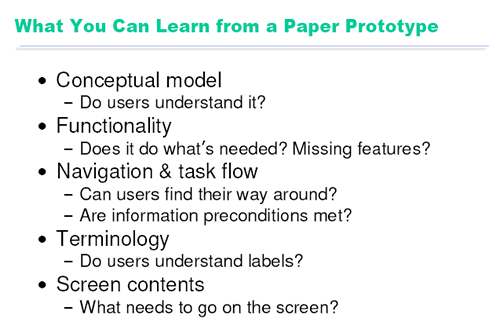|

How to Test a Paper Prototype
怎样测试纸上原型?
Roles for design team设计团队的角色:
- computer “计算机”
- Simulates prototype 模拟原型
- Doesn’t give any feedback that the computer wouldn’t
不要提供任何计算机不能给出的反馈
- Facilitator主持人
- Presents interface and tasks to the user
展示界面和任务给用户
- Encourages user to “think aloud ”by asking questions
鼓励用户提问题,来透视用户的思考
- observer观察者
- keeps mouth shut, sits on hands if necessary
保持嘴巴紧闭,必要的时用手(提供帮助)
- takes copious notes 大量做笔记
Once you’ve built your prototype, you can put it in front of users and watch how they use it. We’ll see much more about user testing in a later lecture, including ethical issues. But here’s a quick discussion of user testing in the paper prototyping domain.
一旦你完成了你的原型构建。你就能拿到用户面前,观看用户怎样使用它。在后面的讲座中我们会学到更多关于用户测试的内容,包括人种方面的问题。这是一个纸上原型领域,在用户测试方面的简短议题。
There are three roles for your design team to fill:
有三个角色由设计团队成员担当:
The computer is the person responsible for making the prototype come alive. This person moves around the pieces, writes down responses, and generally does everything that a real computer would do. In particular, the computer should not do anything that a real computer wouldn’t. Think mechanically, and respond mechanically.
“计算机”(实际)是一个人,负责使原型成为可交互的(生动的)。这个人移动纸片,写下电脑反馈,通常做每件事的结果就像真的计算机要做的那样。特别强调,“计算机”不能做真实电脑办不到的任何事。机械的思考,机械的反馈。
The facilitator is the human voice of the design team and the director of the testing session. The facilitator explains the purpose and process of the user study, obtains the user’s informed consent, and presents the user study tasks one by one. While the user is working on a task, the facilitator tries to elicit verbal feedback from the user, particularly encouraging the user to “think aloud” by asking probing (but not leading) questions. The facilitator is responsible for keeping everybody disciplined and the user test on the right track.
“主持人”是设计团队中的解说人,并且负责指导测试的任务。“主持人”解释用户意图和计划的过程,获得用户的认同,引导用户计划一个一个的任务。当用户正常工作的时候,试图从用户那里获得口头的反馈,特别指出,鼓励用户通过问问题来透视它的思考过程(think aloud)但不能主动引导问题。“主持人”负责使每个人遵守纪律,使用户测试活动在正常的轨道上。
Everybody else in the room (aside from the user) is an observer. The most important rule about being an observer is to keep your mouth shut and watch. Don’t offer help to the user, even if they’re missing something obvious. Bite your tongue; sit on your hands, and just watch. The observers are the primary note takers, since the computer and the facilitator are usually too busy with their duties.
在房子里剩下的人除用户外都是观察者,作为观察者,最重要的规矩就是闭嘴和细致观察。不能给用户提供帮助,甚至,他们在明显的出现错误操作时。忍住不说,用手工作,只是观察。通常,当“计算机”和“主持人”忙碌于他们的职责时,观察者是首要的记录人。

What You Can Learn from a Paper Prototype
从纸上原型你能学到什么?
-
Conceptual mode概念模型
-Do users understand it?用户理解它吗?
-
Functionality功能
-Does it do what’s needed? Missing features?它做到的是否符合需求?缺少什么功能?
-
Navigation & task flow导航和任务流
-Can users find their way around? 用户能找到他们的操作路径吗?
-Are information preconditions met?信息是否考虑预处理?
-
Terminology术语
-Do users understand labels?用户能否理解页签?
-
Screen contents屏幕内容
-What needs to go on the screen?屏幕需要展示哪些(元素)?
Paper prototypes can reveal many usability problems that are important to find in early stages of design. Fixing some of these problems require large changes in design. If users don’t understand the metaphor or conceptual model of the interface, for example, the entire interface may need to be scrapped.
在早期设计阶段,纸面原型可以揭露很多可用性问题,这些问题的发现非常重要。修改这些问题需要对设计做大的改动。如果用户不明白隐喻或界面的概念模型,那么,整个界面都可能需要被废弃。
出处:大智交互设计
责任编辑:moby
上一页 纸张上设计软件产品原型的方法 [2] 下一页 纸张上设计软件产品原型的方法 [4]
|







